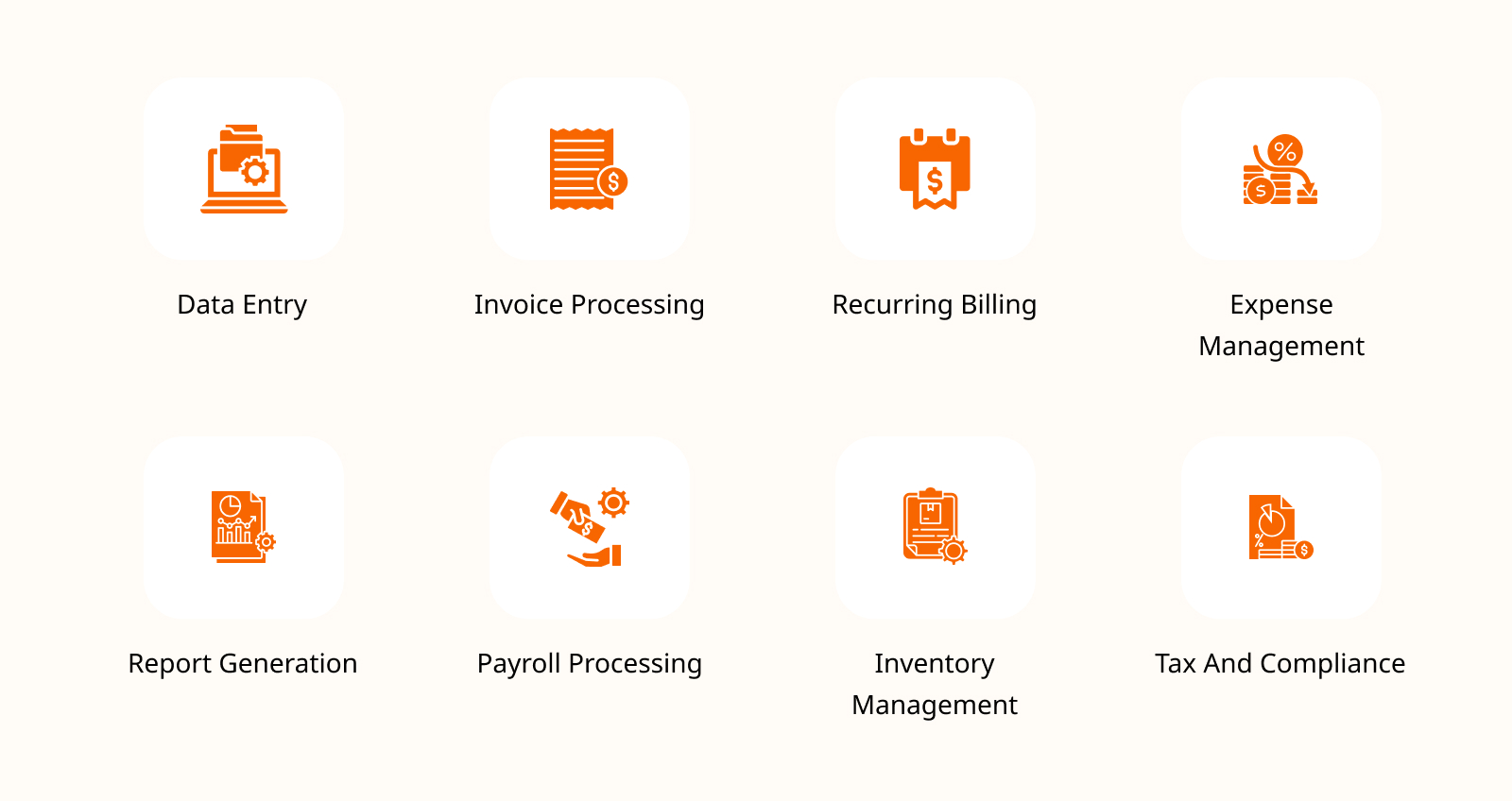The demand for precision, speed, and efficiency in financial management is more critical than ever. This is where accounting automation comes into the picture.
Accounting automation tools have made a significant place in today’s digital world.
According to a recent report by McKinsey, nearly 50% of finance activities can be automated.
However, with lots of tools available, choosing one of them can be overwhelming.
- Which tool streamlines processes seamlessly?
- Which aligns perfectly with our unique business needs?
If you are an accounting professional, many questions like these can come to your mind.
Accounting professionals often find themselves wrestling with mundane tasks: reconciling transactions, generating reports, or manually inputting data, leaving them little time for value-added activities.
Thus, there is a need to optimize the workflow with automation.
Why Need Accounting Automation?
The need for accounting automation has become more than just a convenience — it’s a necessity. Here are some compelling reasons why businesses are embracing these tools:
Enhanced Accuracy
Manual data entry and calculations are prone to human error. One misplaced digit could lead to miscalculations, resulting in financial discrepancies that could harm your business.
Accounting automation ensures precision, minimizes errors, and maintains the integrity of your financial records.
Time Efficiency
Let’s face it—manually handling accounting tasks is time-consuming.
From data entry to reconciliations, the hours spent on these repetitive tasks could be better utilized in more strategic areas of your business.
Automation streamlines these processes, allowing you and your team to focus on higher-value activities that drive growth.
Streamlined Reporting
Generating reports manually involves sifting through heaps of data, compiling information, and formatting it into comprehensive reports.
With accounting automation tools, report generation becomes a breeze.
These tools can extract and analyze data swiftly, providing comprehensive reports at the click of a button.
Regulatory Compliance
Many businesses find it challenging to stay compliant as rules keep changing. Not following them can lead to fines and legal trouble.
Accounting automation tools are made to match these changes, making sure your financial work meets the newest standards and eases your worries.
Improved Workflow
Automation optimizes workflow by creating a seamless process for invoicing, expense tracking, and financial reporting tasks.
It minimizes bottlenecks, facilitates smoother collaboration among team members, and enhances overall productivity.
Cost Savings
Manual accounting processes not only consume time but also money. The resources spent on labor-intensive tasks can be significantly reduced with automation.
Moreover, these tools can save your business from costly mistakes by minimizing errors and improving efficiency.
Accounting Tasks That Can Be Automated
Let’s explore the accounting tasks that automation can easily handle, alleviating pain points and enhancing efficiency.
1. Data Entry: A Tedious Past, An Automated Present
Gone are the days of mind-numbing data entry tasks!
Automation tools swiftly capture, organize, and input financial data, ensuring accuracy while freeing up precious time once spent deciphering handwritten documents or manually inputting numbers.
2. Invoice Processing: From Chaos to Clarity
Automation streamlines the invoice processing journey.
These tools rapidly process invoices, cross-referencing them with purchase orders and receipts, significantly reducing processing time and eliminating human error.
3. Recurring Billing: Automate and Never Miss a Beat
For businesses dealing with recurring payments, automation is a game-changer. It ensures timely billing, reducing the hassle of manual invoicing cycles and minimizing the risk of missed payments.
4. Expense Management: From Chaos to Clarity
Tracking expenses can be overwhelming, but not with automation. Tools categorize and analyze expenses in real time, simplifying approvals, audits, and compliance checks with ease.
5. Report Generation: Insights at Your Fingertips
Generating comprehensive financial reports used to be an uphill task. Automation tools compile and analyze data swiftly, providing valuable insights critical for informed decision-making.
6. Payroll Processing: Accuracy and Timeliness Guaranteed
Automated payroll systems take the headache out of salary calculations, tax deductions, and direct deposits. They ensure accuracy and timely payments while minimizing the potential for payroll-related errors.
7. Inventory Management: Streamlined and Optimized
Efficient inventory management is pivotal for businesses.
Invoicera’s feature-rich solution simplifies inventory control, tracking stock levels, optimizing orders, and offering seamless integration, making it a top choice for businesses seeking a comprehensive inventory management solution.
8. Tax And Compliance: Stay Compliant Effortlessly
Automation ensures adherence to tax regulations by generating accurate reports and flagging potential compliance issues.
It provides peace of mind by minimizing the risk of penalties associated with non-compliance.
9. Audit Trails: Transparent and Accessible Records
Automated audit trails meticulously document financial transactions, creating a transparent and easily accessible history.
These trails prove invaluable during audits and compliance checks.
For businesses searching for a robust inventory management solution, Invoicera stands out with its user-friendly interface and an array of features.
How To Automate Accounting Process?
We have created a step-by-step guide on automating the accounting process:
1. Assess Your Current Workflow
Take a close look at your existing accounting procedures. Identify repetitive tasks that consume a significant amount of time.
This could include data entry, invoice processing, or reconciliation.
2. Choose The Right Accounting Automation Tool
Research and select an accounting automation tool that aligns with your business needs.
Look for software that offers automatic data entry, invoice scanning, expense tracking, and robust reporting capabilities.
3. Integrate Software And Applications
Ensure your chosen accounting tool integrates seamlessly with your existing software and applications.
This integration will allow for smooth data flow between different systems and will reduce manual data entry, minimizing errors.
4. Set Up Automation Workflows
Take advantage of the automation features provided by the tool. Create workflows that automate repetitive tasks.
For instance, set up rules to automatically categorize expenses, schedule recurring invoices, or generate regular financial reports.
5. Train Your Team
Ensure your team is well-trained to use the accounting automation tool.
Offer training sessions or tutorials to familiarize them with the features and functionalities.
Encourage them to explore and make the most out of the software.
6. Regularly Review And Optimize
Periodically review your automated processes. Analyze the efficiency of the automation workflows and identify areas for improvement.
Stay updated with software updates and new features that could further optimize your accounting tasks.
7. Embrace Continuous Improvement
Accounting automation is not a one-time task. Embrace a culture of continuous improvement.
Stay open to new tools, technologies, and methodologies that can further enhance your accounting automation processes.
Conclusion
Time is money! And these automation tools offer invaluable benefits.
From simplifying invoicing and expense tracking to facilitating seamless integration with other business systems, the versatility and functionalities of these tools cater to diverse accounting needs.
As businesses evolve, embracing these technologies becomes an option and a necessity. The competitive edge that automation provides can’t be overstated.
It’s about working smarter, not harder, and these tools illustrate this quality perfectly.
The journey toward automation might seem daunting, but it’s a leap that pays off exponentially.
Embrace the power of these accounting automation tools, tailor them to your business needs, and watch as they elevate your financial processes to new heights.



